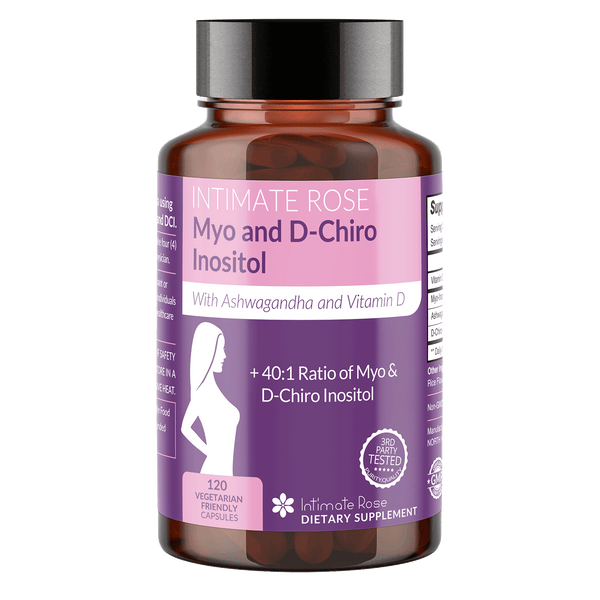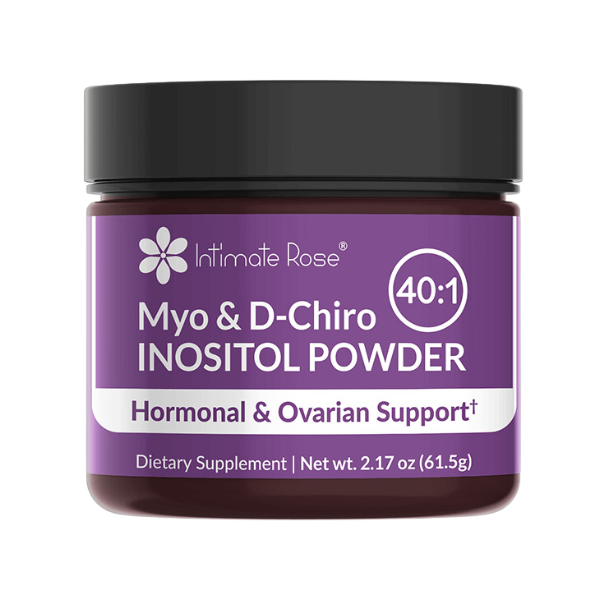In recent years, inositol has been gaining widespread popularity in the health community as a treatment option for women suffering from polycystic ovary syndrome, more commonly referred to as PCOS.
However, as you start to dive into the potential health benefits of supplementing with inositol, you’ll likely run into a myriad of confusing information regarding what form and dosage of inositol is likely to achieve the best results in combatting the symptoms of PCOS.
For starters, there are two common forms of inositol (myo-inositol) and d-chiro inositol, and some sources disagree on the best form to take. So how do you get past the intimidating scientific mumbo-jumbo to sort out the straight facts on myo-inositol vs. d-chiro inositol?
We’ve compiled a quick guide on the difference between the two forms of inositol to help you make an informed decision on your road toward better health and well being.
Things Off Down There?
Where Does Inositol Come From?
In order to understand the difference between the two forms of inositol, it’s first important to understand where inositol comes from, the role it plays on insulin regulation, and how that relates to the symptoms of PCOS.
Inositol is categorized as a b-vitamin (sometimes called Vitamin B8), but it's actually a form of sugar with antioxidant properties that is naturally occurring within our bodies and also found in some common foods.
Naturally Occurring in Mammalian Tissues
Also known more accurately as myo-inositol, this carbocyclic sugar is abundantly found in the brain as well as other tissues.
Inositol plays a few major roles in our bodies. First, it plays a structural role in our cell membranes. Inositol’s other primary function is that of a messenger, sending signals to the body to influence the action of insulin and other brain chemicals such as serotonin and dopamine.
Diet
In addition to being found naturally in our bodies, inositol can also be found naturally in a variety of healthy foods such as grains, nuts, beans, fresh vegetables, and fruit.
Myo-inositol vs D-chiro inositol
One of the reasons it’s so hard to find a straight answer on the difference between myo- and d-chiro inositol is that the two forms are nearly identical on a molecular level. In fact, if you compare the two side by side, they actually form a mirror image of one another. To the untrained individual, this may cause some confusion.
However, although they look nearly identical side by side, if you were to overlay them on each other, you’d notice they just don’t quite match up.
That tiny difference between the two forms is what allows each to play a completely different role in signaling insulin and other physiological pathways in our bodies. Myo-inositol helps the transporters' activation and the body’s use of glucose while d-chiro inositol is involved in glycogen synthesis and storage.
Naturally, our bodies actually take myo-inositol and convert a portion of it into d-chiro inositol. When this process is running optimally, we should have both myo-inositol and d-chiro inositol in a majority of our tissues at a rate of 40:1. However, it’s been noted in women who suffer from PCOS that their bodies often have trouble effectively converting myo-inositol into d-chiro inositol, and the interruption of this important process plays a direct role in the insulin resistance so often seen in PCOS patients.
Which inositol is better suited for helping treat the symptoms of PCOS?
It has long been believed within the medical community that insulin resistance is one of the symptoms that often contributes to infertility in women who have been diagnosed with PCOS.
Given inositol’s important role in regulating the body’s insulin functions, it didn’t take long for the health industry to start researching inositol as a possible treatment for PCOS.
Most of the early studies focused primarily on myo-inositol often taken in conjunction with folic acid. Those early studies showed great promise, and as a result, you will often still find myo inositol supplements marketed toward women with PCOS.
Studies on women taking high doses of d-chiro inositol alone, on the other hand, didn’t show much promise.
However, as further studies have been performed on inositol, it has been discovered that optimal results can be seen in patients using a combination of myo- and d-chiro inositol.
This is because our bodies rely on myo-inositol and d-chiro inositol working together as a team to mediate insulin action. Therefore, most health professionals now recommend a blend of myo- and d-chiro inositol at a ratio of 40:1 for the treatment of PCOS.
How does the Inositol supplement work?

How does inositol work to potentially improve health?
As mentioned, inositol is often touted as a potential natural health supplement for those with PCOS and metabolic syndrome. But how (and why) does it work?
Inositol is a major natural component of cell membranes, and it is theorized that inositol may play a key role in balancing various chemicals within the body. It may also enhance the effect of insulin in the body.
Other research has demonstrated inositol’s ability to affect various neurotransmitters in the brain (i.e. dopamine and serotonin), and thus as also been suggested as a potential adjuvant for stress, anxiety and depression.
Closing Thoughts About Inositol and D-chiro Inositol
Although further research is needed to substantiate claims, existing research and clinical trials demonstrate that this supplement may have a key role in helping individuals with various health conditions, especially PCOS and metabolic syndrome.
We already know that both forms of inositol, myo and d-chiro, serve very important yet separate functions in the body. When working together as a team at an optimum concentration of 40 myo-inositol to one d-chiro inositol, the body’s insulin regulation is able to function in its ideal state.
Supplementation is, therefore, most impactful when selected to mirror the body’s ideal inositol ratio, making an inositol supplement containing 40:1 myo- to d-chiro inositol the ultimate form of inositol to combat insulin resistance caused by polycystic ovary syndrome.
As with any type of supplementation, always consult your primary care physician before beginning any type of new regimen.

Things Off Down There?















